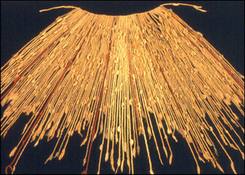For decades, researchers have been trying to decipher the system of connections that was apparently used by the Incas as a script. Will the solution come through a computerized database?

The Kipo knots. Accounts, a translation of the Quechua language, a binary language, an annual budget book or all of these together?
Direct link to this page: https://www.hayadan.org.il/inkahandwriting.html
To the lay observer, they may look like little more than a tangle of threads and knots. But a growing number of experts believe that the ties of the "kipo" contain the secret of the mighty Inca Empire, which in the middle of the second millennium ruled most of the western part of South America, from Colombia in the north to Chile in the south, until it was conquered by the Spanish.
The Incas left behind enormous achievements, especially in the field of architecture - including thousands of kilometers of paved roads, advanced irrigation systems and massive stone buildings culminating in the "Lost City" of Machu Picchu - astonishing achievements even in the light of modern architecture, especially for a culture that never invented the wheel.
One of the main reasons for the helplessness of researchers in the long-standing attempt to decipher the secrets of the Incas, is the lack of written documentation, explaining how the Incas reached their great achievements. This riddle left the anthropologists in shock, who define a written language as one of the necessary conditions for the existence of an advanced culture.
This is where the Kipo knots come into play. The kippo knots are collections of cotton and woolen threads of various lengths, connected by knots of various shapes, colors and compositions, the use of which was widespread throughout the empire. According to the testimonies of the Spanish, the Incas were seen "reading" the threads, and it was estimated that they were mainly used as complex invoices.
For the past 25 years, the knots of the Kipo have occupied the British textile engineer William Burns, who has been living for 50 years in Peru, where the center of the Inca Empire was located. In his book "Deciphering the Kipo", which was published this year in Spanish, Burns claims that the connections are actually phonetic abbreviations of the Quechua language, the spoken language that is still the mother tongue of the vast majority of the inhabitants of the Indian Andes, who are about 80-90% of the population of Bolivia. Peru and Ecuador. In anthropological research, it has been widely believed until now that Quechua does not have a script. In any case, Burns still did not succeed in actually deciphering the connections.
Most of the kippo were destroyed by the Spanish conquerors, and researchers have so far been unable to decipher any of those that remain. Anthropologist Gary Orton from Harvard University in the USA estimates that today there are about 600 Kipu in museums, and he studied about 450 of them in Peru, Chile, the USA and Germany. In his book, "The Kipu Symbols of the Incas", Orton claims that the Kipu was actually a script of 1,536 characters arranged according to the binary principle (the principle according to which the ASCII language, the language read by personal computer processors, is built). The writing was known to a very limited number of educated among the Incas.
Orton is currently assisted by Kari Brezin, a database expert, mathematician and weaver, to prepare a computerized database that includes all existing kippo. With the help of the database, which is expected to be complete by the middle of 2004, Orton hopes that it will be possible to fully decipher the script.
Another researcher who studies the kippo is Frank Solomon, an anthropologist from the University of Wisconsin. Solomon, who is also expected to publish a book on Kipo next year, recently found more Kipo ties in the hands of Indians in the small, high and remote village of Topicocha in central Peru. Although the natives cannot read the script, they pass the kippo from generation to generation in a ritualistic manner. Even for Solomon the Kipo is still an enigma, but he also has high hopes in the future pool of Orton and Barzin.
Solomon believes that a few of the natives could still read the kippo at the beginning of the 20th century, when it was abandoned as part of the Peruvian authorities' policy to promote modernization. Solomon supports the theory that the Kifu served as a kind of "annual budget book", and its main use was for numerical calculations.
Meanwhile, the Kipo knots are still a mystery. "My hope is that from his seat he will pass my theory on, or add another layer to it, or even propose a completely new theory - because right now, we are stuck in place," concludes Orton.
https://www.hayadan.org.il/BuildaGate4/general2/data_card.php?Cat=~~~675362494~~~162&SiteName=hayadan
